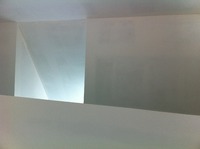Reflections on Norris
 Thursday, February 24, 2011 at 7:33AM
Thursday, February 24, 2011 at 7:33AM I was asked to visit the Norris House project and provide my impressions regarding the interior design of the home based on discussions with students and faculty working on the design and construction. On On February 18 I traveled about 20 minutes outside of Knoxville to the community of Norris. This home is a collaborative effort between industry, education, and community. For more specifics on the project visit the Norris website.
http://www.thenewnorrishouse.com/index.htm
I was struck by three formal aspects of the home that could potentially shape the perception of the interior space.
Light
The design of the home has a strong quality of capturing and revealing light in a manner that reveals the spatial qualities of the home. The dormer and skylights reveal the folded, angular overhead planes. This is a striking quality that should be enhanced by a unifying surface to desolve the material and reveal the folder enclosure. By emphasizing the folded overhead planes this should enhance the feeling of living under a roof or shelter.
Frame
The window and the doors located on the wall directly opposite of the window create a strong axial condition that links the interior and exterior condition. The widow and door are links to the landscape and the natural wooded surroundings. These views have to potential to be "framed" composition and studies should be conducted to extend the perception of the interior through these framed views. The spatial qualities of the room should extend through the framed view and allow elements of the interior and exterior to exist in the space directly beyond the glazed surfaces. Create a composition in the frames.
Transition
The small scale of the house demands that attention be paid to the transitional elements of the interior. One of the most important opportunities is the swing space. The swing space plays a major part in the utilitarian and poetics of the space on a formal and social level. The space should be maximized for the potential for being "both and" a place where it can extend and confine, be social and private. This "both and" aspect can be maximized by emphasizing the transitional aspect of the space and proving a threshold condition that is malleable and changed buy the user to modify the perception of the space and the utilitarian potential. An element such a counter, or work surface that can swing between the spaces can mediate the transition and provide multiple experiences to extend the small scale to a larger perception and function.
The above formal aspects of the space are to be complemented and relate to social/community concepts.
Integration
How do we meet and become part of the community. The Norris house in the newcomer. To be accepted to community one needs to start to meet the community where it is and build a relationship between the beauty of what the community offers and the potential of where it can grow. This is a delicate balance of realizing that one my see great potential, but must demonstrate restraint to build relationship. The quality of the interior space must have elements that build on the existing strengths of the community. What elements of color, form, and shape can be introduced as part of the interior elements? How are they introduced in a way that respects the existing cultural condition and extends the potential of the community?




Reader Comments